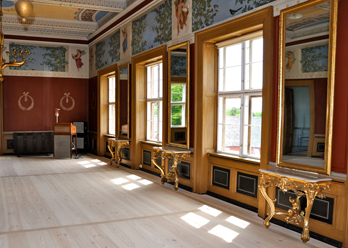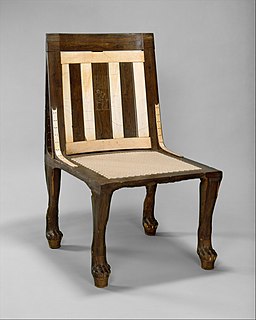
Furniture refers to movable objects intended to support various human activities such as seating, eating (tables), and sleeping. Furniture is also used to hold objects at a convenient height for work, or to store things. Furniture can be a product of design and is considered a form of decorative art. In addition to furniture's functional role, it can serve a symbolic or religious purpose. It can be made from many materials, including metal, plastic, and wood. Furniture can be made using a variety of woodworking joints which often reflect the local culture.

A desk or bureau is a piece of furniture with a flat table-style work surface used in a school, office, home or the like for academic, professional or domestic activities such as reading, writing, or using equipment such as a computer. Desks often have one or more drawers, compartments, or pigeonholes to store items such as office supplies and papers. Desks are usually made of wood or metal, although materials such as glass are sometimes seen.

In architecture a corbel is in medieval architecture a structural piece of stone, wood or metal jutting from a wall to carry a superincumbent weight, a type of bracket. A corbel is a solid piece of material in the wall, whereas a console is a piece applied to the structure. A piece of timber projecting in the same way was called a "tassel" or a "bragger" in England.
A cup holder is a device, such as a zarf, to hold a cup or other drinking vessel. It may be free standing to hold cups securely on a desk or other flat surface, or in a tree style to store sets of cups in kitchens. They may be built into automobiles or chairs, or fixed to the walls of airplanes, boats, buses and trains.

A commode is any of many pieces of furniture. The Oxford English Dictionary has multiple meanings of "commode". The first relevant definition reads: "A piece of furniture with drawers and shelves; in the bedroom, a sort of elaborate chest of drawers ; in the drawing room, a large kind of chiffonier." The drawing room is itself an term for a formal reception room, and a chiffonier is, in this sense, a small sideboard dating from the early 19th century.

A table is an item of furniture with a flat top and one or more legs, used as a surface for working at, eating from or on which to place things. Some common types of table are the dining room table, which is used for seated persons to eat meals; the coffee table, which is a low table used in living rooms to display items or serve refreshments; and the bedside table, which is used to place an alarm clock and a lamp. There are also a range of specialized types of tables, such as drafting tables, used for doing architectural drawings, and sewing tables.

A butt joint is a technique in which two pieces of material are joined by simply placing their ends together without any special shaping. The name 'butt joint' comes from the way the material is joined together. The butt joint is the simplest joint to make since it merely involves cutting the wood to the appropriate length and butting them together. It is also the weakest because unless some form of reinforcement is used it relies upon glue alone to hold it together. Because the orientation of the wood usually presents only one end to long grain gluing surface, the resulting joint is inherently weak.

The tensor fasciae latae is a muscle of the thigh. Together with the gluteus maximus, it acts on the iliotibial band and is continuous with the iliotibial tract, which attaches to the tibia. The muscle assists in keeping the balance of the pelvis while standing, walking, or running.
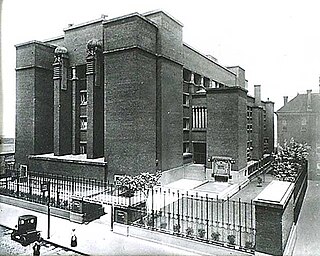
The Larkin Building was an early 20th century building. It was designed in 1903 by Frank Lloyd Wright and built in 1904-1906 for the Larkin Soap Company of Buffalo, New York. The five story dark red brick building used pink tinted mortar and utilized steel frame construction. It was noted for many innovations, including air conditioning, built-in desk furniture, and suspended toilet partitions and bowls. Though this was an office building, it still caught the essence of Frank Lloyd Wright's type of architecture. Sculptor Richard Bock provided ornamentation for the building.
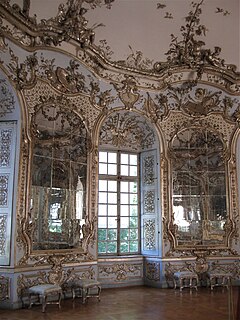
A pier glass or trumeau mirror is a mirror which is placed on a pier, i.e. a wall between two windows supporting an upper structure.

A poker table or card table is a table specifically designed for playing card games.
A folding table is a type of folding furniture, a table with legs that fold up against the table top. This is intended to make storage more convenient and to make the table more portable. Many folding tables are made of lightweight materials to further increase portability.
Italian Baroque interior design refers to high-style furnishing and interior decorating carried out in Italy during the Baroque period, which lasted from the early 17th to the mid-18th century. In provincial areas, Baroque forms such as the clothes-press or armadio continued to be made into the 19th century.
Italian Rococo interior design refers to interior decoration in Italy during the Rococo period, which went from the early 18th century to around the 1760s.

The Noguchi table is a piece of modernist furniture first produced in the mid-20th century. Introduced by Herman Miller in 1947, it was designed in the United States by Japanese American artist and industrial designer Isamu Noguchi. The Noguchi table comprises a wooden base composed of two identical curved wood pieces, and a heavy plate glass top.

A cabinet is a box-shaped piece of furniture with doors and/or drawers for storing miscellaneous items. Some cabinets stand alone while others are built in to a wall or are attached to it like a medicine cabinet. Cabinets are typically made of wood, coated steel, or synthetic materials. Commercial grade cabinets, which differ in the materials used, are called casework, casegoods, or case furniture.
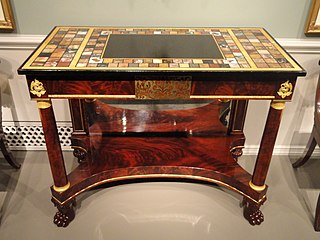
A pier table is a table designed to be placed against a wall, either between two windows or between two columns. It is also known as a console table.

Louis XIV furniture was massive and lavishly covered with sculpture and ornament of gilded bronze in the earlier part of his personal reign (1660–1690). After about 1690, thanks in large part to the furniture designer André Charles Boulle, a more original and delicate style appeared. It was based on the use of marquetry, the inlay of piece of ebony and other rare woods, a technique first used in Florence in the 15th century, which was refined and developed by Boulle and others working for the King. Furniture was inlaid with thin plaques of ebony, copper, mother of pearl, and exotic woods of different colors in elaborate designs.

Louis XVI furniture is characterized by elegance and neoclassicism, a return to ancient Greek and Roman models. Much of it was designed and made for Queen Marie Antoinette for the new apartments she created in the Palace of Versailles, Palace of Fontainebleau, the Tuileries Palace, and other royal residences. The finest craftsmen of the time, including Jean-Henri Riesener, Georges Jacob, Martin Carlin, and Jean-François Leleu, were engaged to design and make her furniture.

